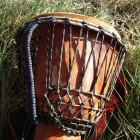 At a weekly market in San Pancho, Mexico (a small town up the coast from Puerto Vallarta), a musical trio called Caravan provided the live entertainment for the day. A talented flamenco-style guitarist, a versatile female singer, and a conga player. The drummer had an improvised kit of sorts, as he sat on a cajon, with one foot operating a cowbell pedal, and the other a pedal for cymbal. But for the most part he stuck to a simple tumbao pattern on the single conga:
At a weekly market in San Pancho, Mexico (a small town up the coast from Puerto Vallarta), a musical trio called Caravan provided the live entertainment for the day. A talented flamenco-style guitarist, a versatile female singer, and a conga player. The drummer had an improvised kit of sorts, as he sat on a cajon, with one foot operating a cowbell pedal, and the other a pedal for cymbal. But for the most part he stuck to a simple tumbao pattern on the single conga:
H t g d H t P t
I have long known of this rhythm as a staple of the Afro-Latin genre, but never noticed it being relied on for virtually a whole set of diverse popular, classical, and Latin-style songs.
The repetitive nature of this particular rhythm reminded me of another concert I witnessed in Victoria, BC about twenty years ago. Juno Award-winner Alpha Yaya Diallo (on guitar and vocals) fronted a band featuring a talented djembe player, likely also from Guinea, who occasionally was set loose to show his chops. But for 90 percent of the show, I was amazed to see him confined to the same simple accompaniment rhythm, which any beginning djembe player will recognize as the basic part for Kuku:
G – g d – – P –
I was struck by the similarly confined role of both of these talented drummers separated by time, geography and culture, given the emphasis of the music they were supporting. And now for the first time I realized the universality of the rhythm they both played, as the tumbao and the Kuku part are essentially the same archetypal rhythm.
Both start grounded with the bass downbeat on the 1, follow with a double tone upbeat, an understated downbeat on the 2, and a final upbeat slap.

It’s a proven formula, suitable for virtually any 4/4 song, to provide both a stable downbeat structure and an uplifting offbeat counterpoint. The unstressed extra notes on conga (unbolded, below) serve only as timekeepers.
To explore further the many overlaps between traditional African and Afro-Latin rhythms, choose from any books in the Roots Jam series. And let me know what other lookalikes you discover!

